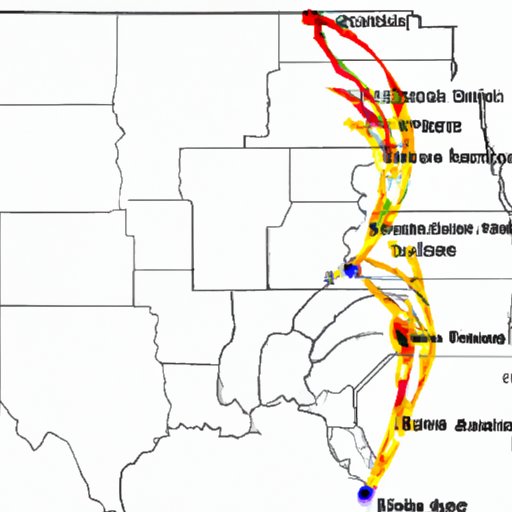Introduction
Tornadoes are some of the most powerful and destructive natural phenomena on Earth. These rapidly rotating columns of air can cause tremendous destruction in a short amount of time and leave behind a trail of devastation. Despite their fearsome power, there is still much to learn about these weather events. One important question is: where does the most tornadoes occur? In this article, we will explore the geography of tornado occurrence, factors that influence tornado formation, and the climate conditions that lead to tornado development. We will also analyze historical data to determine which areas have experienced the highest number of tornadoes, and map out the region known as “Tornado Alley” and the states within it.

Examining the Geography of Tornado Occurrence
Tornadoes can occur almost anywhere in the world, but certain geographic locations tend to experience more tornado activity than others. In the United States, for example, tornadoes are most common in the Great Plains region, which stretches from Texas to North Dakota. This area is known as “Tornado Alley” due to its high frequency of tornado occurrences. Other regions around the world also have higher-than-average tornado activity, such as Central and Eastern Europe, Bangladesh, and Southern Africa.
There are several reasons why certain areas are more prone to tornadoes than others. One factor is the presence of warm, moist air and cold, dry air. When these two air masses collide, they create an unstable atmosphere that can lead to storms and, eventually, tornadoes. Additionally, geographic features like mountains and bodies of water can affect the formation of tornadoes by influencing wind patterns.

Exploring the Reasons Behind Tornado Hotspots
Tornado formation is influenced by several factors, including temperature, humidity, and wind speed. Warmer temperatures create an atmosphere that is more conducive to storm development, while higher levels of humidity increase the likelihood of thunderstorms. Wind shear, or the difference in wind speed between different layers of the atmosphere, is also important for tornado formation. When winds at different levels of the atmosphere blow in different directions, the resulting instability can cause a tornado.
Certain areas are more prone to tornadoes than others due to the unique combination of temperature, humidity, and wind speed. The United States’ Tornado Alley is one such hotspot, comprising the states of Texas, Oklahoma, Kansas, Nebraska, South Dakota, and North Dakota. This region experiences a large number of tornadoes each year due to its location in the center of the country and its proximity to the Gulf of Mexico, which provides a source of warm, moist air.
Investigating the Climate Conditions that Lead to Tornado Formation
Climate conditions play a major role in the formation of tornadoes. The presence of warm, moist air creates an environment that is favorable for thunderstorms, which can eventually lead to tornadoes. Additionally, wind shear is necessary for tornado development, as the difference in wind speed between different layers of the atmosphere helps to destabilize the air. Finally, the presence of a strong jet stream or other mid-level winds can help to further destabilize the air and contribute to tornado formation.
These climatic conditions are often found in the same areas where tornadoes occur most frequently. For instance, the Great Plains region experiences frequent thunderstorms due to its location near the Gulf of Mexico, which provides a steady source of warm, moist air. Additionally, the area is prone to wind shear due to the presence of mountains and bodies of water, both of which can affect the flow of the atmosphere.

Analyzing Historical Data to Determine Where Tornadoes Strike Most Frequently
In addition to examining the climate conditions that lead to tornado formation, historical data can be used to determine which areas have experienced the highest number of tornadoes. By analyzing records of past tornado occurrences, researchers can get an idea of which areas have been hit the hardest by these powerful storms. In the United States, for example, records show that the states of Texas, Oklahoma, Kansas, Nebraska, South Dakota, and North Dakota have experienced the highest number of tornadoes in recent years.
When looking at historical data, it’s important to note that tornado activity can vary from year to year. While some years may see a higher number of tornadoes than others, the overall trend over time is usually fairly consistent. This means that the areas with the highest number of tornadoes in recent years are likely to remain hotspots for tornado activity in the future.
Mapping Out Tornado Alley: Where are the Most Tornadoes Reported?
The region of the United States known as “Tornado Alley” is one of the most active areas for tornado occurrence. This area comprises the states of Texas, Oklahoma, Kansas, Nebraska, South Dakota, and North Dakota, and has experienced a high number of tornadoes in recent years. In fact, records show that this region has experienced more tornadoes per square mile than any other region in the country.
The states of Tornado Alley are particularly vulnerable to tornadoes due to their location in the center of the country and their proximity to the Gulf of Mexico. The warm, moist air from the Gulf combined with the cold, dry air from the Rocky Mountains creates an ideal environment for thunderstorm and tornado development.
Conclusion
In this article, we explored where the most tornadoes occur by examining the geography of tornado occurrence, factors that influence tornado formation, and the climate conditions that lead to tornado development. We also analyzed historical data to determine which areas have experienced the highest number of tornadoes, and mapped out the region known as “Tornado Alley” and the states within it. Understanding the geography of tornado occurrence and the climate conditions that lead to tornado formation can help people living in areas prone to tornadoes take necessary precautions to stay safe.


